 W
WDESUCA is a rechargeable contactless smart card ticketing system for public transport in Kōchi Prefecture, Japan, introduced from 25 January 2009. The card is issued by the DESUCA Company , founded by Tosa Electric Railway (Tosaden) and Kōchiken Kōtsū. Following the restructuring of the two founder companies, the company is now an affiliate of Tosaden Kōtsū. The name stands for tram , bus and card.
 W
WHareca is a rechargeable contactless smart card ticketing system for public transport in Okayama, Japan, introduced by Okayama Electric Tramway (Okaden), Ryōbi Bus, and Shimotsui Dentetsu (Shimoden), from October 1, 2006. The name comes from hare and card, meaning the card for Okayama, the sunny city. Just like JR East's Suica or JR West's ICOCA, the card uses RFID technology developed by Sony corporation known as FeliCa.
 W
WHayakaken (はやかけん) is a rechargeable contactless smart card ticketing system for public transport in Fukuoka, Fukuoka Prefecture, Japan. Fukuoka City Transportation Bureau introduced the system on March 7, 2009.
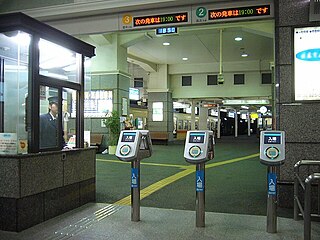 W
WIC e-card is a rechargeable contactless smart card ticketing system for public transport by Iyo Railway (Iyotetsu) in Matsuyama, Japan. The card was introduced from August 23, 2005, succeeding the previous e-card, a magnetic prepaid card. This is the first smart card system by Japanese transportation operators with Osaifu-Keitai mobile payment service, preceding that of Mobile Suica.
 W
WICa is a rechargeable contactless smart card ticketing system for public transport in Kanazawa, Japan, introduced by Hokuriku Railroad (Hokutetsu), from December 1, 2004. The name is the portmanteau of IC and card, as well as ai (love), hoping the card will be loved by users. Just like JR East's Suica or JR West's ICOCA, the card uses RFID technology developed by Sony corporation known as FeliCa. There is a mascot fairy character called ICa-chan .
 W
WThe ICOCA card is a rechargeable contactless smart card used on the JR West rail network in Japan. The card was launched on November 1, 2003 for usage on the Urban Network, which encompasses the major cities of Osaka, Kyoto and Kobe (Keihanshin). It is now usable on many other networks. The ICOCA area has gradually been expanded, and now includes the San'yo region through the Okayama and Hiroshima urban areas, and some lines in northern Shikoku, San'in and Hokuriku regions as of 2020.
 W
WIruCa is a rechargeable contactless smart card ticketing system for public transport introduced by Takamatsu-Kotohira Electric Railroad (Kotoden) in Takamatsu, Japan from February 2, 2005. The name comes from IC and iruka (dolphin), the latter being the mascot character of the company. Just like JR East's Suica or JR West's ICOCA, the card uses RFID technology developed by Sony corporation known as FeliCa. As of July 2006, 77,000 cards are issued.
 W
WKitaca is a rechargeable contactless smart card ticketing system for public transport in Sapporo, Japan. Hokkaidō Railway Company introduced the system from October 25 2008. Its name means "the card of north ", while 北 is also the first character of Hokkaidō (北海道). Like other electronic fare collection systems in Japan, the card uses RFID technology developed by Sony corporation known as FeliCa. The card has an official mascot of Ezo momonga, a kind of flying squirrel found in Hokkaidō. The mascot is designed by Sora, an illustrator who lives in Sapporo.
 W
WLuLuCa (ルルカ) is a rechargeable contactless smart card ticketing system for public transport in Shizuoka, Japan, introduced by Shizuoka Railway (Shizutetsu) group, from March, 2006. The card is officially called SHIZUTETSU CARD LuLuCa. Just like JR East's Suica or JR West's ICOCA, the card uses RFID technology developed by Sony corporation known as FeliCa. Shizutetsu group also introduced PiTaPa and ICOCA from September 2007 for their lines. Although normal LuLuCa cards cannot be used on regular PiTaPa or ICOCA systems, ten of the most popular IC cards in Japan can be used on LuLuCa, as of 2013.
 W
WManaca, written in lower-case letters, manaca is a rechargeable contactless smart card used in Nagoya, Japan and the surrounding area since February 11, 2011, when it replaced the Tranpass magnetic fare card system. As of March 23, 2013, it became compatible with 9 other IC cards, allowing it to be used nationwide.
 W
WSuica is a rechargeable contactless smart card, electronic money used as a fare card on train lines in Japan, launched on November 18, 2001. The card can be used interchangeably with JR West's ICOCA in the Kansai region and San'yō region in Okayama, Hiroshima, and Yamaguchi prefectures, and also with JR Central's TOICA starting from spring of 2008, JR Kyushu's SUGOCA, Nishitetsu's Nimoca, and Fukuoka City Subway's Hayakaken area in Fukuoka City and its suburb areas, starting from spring of 2010. The card is also increasingly being accepted as a form of electronic money for purchases at stores and kiosks, especially within train stations. As of 2018, JR East reports 69.4 million Suica UID's have been issued, usable at 476,300 point of sale locations, with 6.6 million daily transactions.
 W
WNagasaki Smart Card is a contactless smart card system used in Nagasaki, Japan. Its operators are Nagasaki Electric Tramway and six bus companies, namely, Nagasaki Bus, Nagasaki Prefectural Bus, Saihi Bus, Saikai Kōtsū, Sasebo Municipal Bus, and Shimatetsu Bus. The system uses Sony FeliCa technology, the same as that used in the Octopus card in Hong Kong, EZ-Link in Singapore and Suica on JR East.
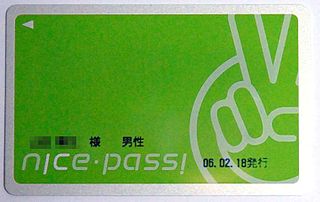 W
WNicePass is a rechargeable contactless smart card ticketing system for public transport in Hamamatsu, Japan, introduced by Enshū Railway (Entetsu) group, from August 20, 2004, succeeding the previous ET Card, a magnetic prepaid card. The name is an acronym of New Intelligence Card of Entetsu Personal and Smart System. Just like JR East's Suica or JR West's ICOCA, the card uses RFID technology developed by Sony corporation known as FeliCa. This was the first smart card in Japan that is usable for both railway lines and bus lines.
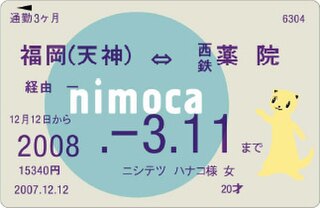 W
WNimoka, written in lower-case letters, nimoca , is a rechargeable contactless smart card ticketing system for public transport in Fukuoka Prefecture, Japan. Nishi-Nippon Railroad (Nishitetsu) introduced the system on May 18, 2008. Its name is an acronym of "nice money card", while nimo (にも) in Japanese means "also," as the card is usable also on buses, also on trains, also for shopping, etc. Like other electronic fare collection systems in Japan, the card uses FeliCa, RFID technology developed by Sony. On March 13, 2010, nimoca was interoperated with two similar cards in Fukuoka—SUGOCA from Kyūshū Railway Company and Hayakaken from Fukuoka City Transportation Bureau—plus Suica, a card used in Greater Tokyo Area by East Japan Railway Company. The card features a ferret as the official mascot.
 W
WPasmo is a rechargeable contactless smart card, electronic money system. It is primarily used for public transport in Tokyo, Japan, where it was introduced on March 18, 2007. Pasmo can also be used as a payment card for vending machines and stores.
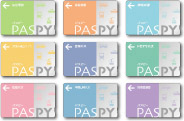 W
WPASPY is a rechargeable contactless smart card ticketing system for public transit in Hiroshima Prefecture, Japan. Its name is a portmanteau of pass, happy, and speedy. Like other electronic fare collection systems in Japan, the card uses an RFID technology developed by Sony known as FeliCa, but was the first to employ an 8 KB capacity instead of the standard 4, owing to the need for more capacity to interoperate with the Hiroshima bus system.
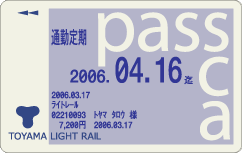 W
Wpass-ca is a rechargeable contactless smart card ticketing system for public transport in Toyama, Japan, introduced by Toyama Light Rail, from April 29, 2006. The card is accepted by Toyamakō Line, the only line the company operates. Just like JR East's Suica or JR West's ICOCA, the card uses RFID technology developed by Sony corporation known as FeliCa. However, pass-ca has no known plan to have integrated services with those other cards.
 W
WPassnet was a stored-fare system using magnetic cards of the 22 members of the Passnet Association in the Kantō region of Japan. It was available between October 14, 2000 and January 11, 2008 in 1,000, 3,000 and 5,000 yen varieties. There were also 500-yen ones in tailor-made designs for ceremonies such as weddings and funerals, most of which are presumably still remained to be known.
 W
WPiTaPa is a contactless smart card ticketing and electronic money system used in the Kansai region of Japan. The name PiTaPa is an acronym of "Postpay IC for Touch and Pay". As of 2007, the card can be used on 19 train systems and 11 buses, including the Osaka Municipal Subway and New Tram, the Keihan Electric Railway, and the Hankyu Railway.
 W
WRapiCa is a rechargeable contactless smart card ticketing system for public transport in Kagoshima, Japan, introduced by Kagoshima City Transportation Bureau, Nangoku Kōtsū, and JR Kyūshū Bus, from April 1, 2005. The name is the acronym of Rapid and Pay Intelligent Card. Just like JR East's Suica or JR West's ICOCA, the card uses RFID technology developed by Sony corporation known as FeliCa. The card is usable in all the tramway lines of Kagoshima City Transportation Bureau, as well as most bus lines of the three operators.
 W
WRyuto is a rechargeable contactless smart card ticketing system for public transport in Niigata, Japan, introduced by Niigata Kotsu.
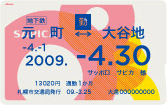 W
WSAPICA is a rechargeable contactless smart card ticketing system for public transport in Sapporo, Japan. Sapporo City Transportation Bureau (SCTB) introduced the system from January 30, 2009. The name of the card means "Sapporo's IC card". Sa' (サッ) is also the sound symbolic word for quickly pulling a card out and pi' (ピッ) is the sound equivalent to "beep". The card is issued by Sapporo Information Network Company , the third sector company of Sapporo City Government.
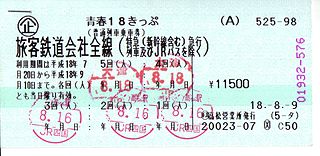 W
WThe Seishun 18 Ticket is a special discount ticket issued in Japan which allows holders one-day unlimited rides on the local trains of Japan Railways Group during limited periods of year.
 W
WSUGOCA is a Japanese rechargeable contactless smart card ticketing system for public transport in Fukuoka Prefecture and environs. The Kyūshū Railway Company introduced the system on 1 March 2009. The name is an acronym of "Smart Urban GOing CArd", while sugoka (凄か) in the local Kyūshū dialect means "great". Like other electronic fare collection systems in Japan, the card uses RFID technology developed by Sony Corporation, known as FeliCa. American graphic artist Rodney Greenblat designed its official mascot, a frog with a clock.
 W
WSuica is a rechargeable contactless smart card, electronic money used as a fare card on train lines in Japan, launched on November 18, 2001. The card can be used interchangeably with JR West's ICOCA in the Kansai region and San'yō region in Okayama, Hiroshima, and Yamaguchi prefectures, and also with JR Central's TOICA starting from spring of 2008, JR Kyushu's SUGOCA, Nishitetsu's Nimoca, and Fukuoka City Subway's Hayakaken area in Fukuoka City and its suburb areas, starting from spring of 2010. The card is also increasingly being accepted as a form of electronic money for purchases at stores and kiosks, especially within train stations. As of 2018, JR East reports 69.4 million Suica UID's have been issued, usable at 476,300 point of sale locations, with 6.6 million daily transactions.
 W
WTOICA is a rechargeable contactless smart card ticketing system for JR Central railway network which was introduced in the Chūkyō Area of Japan on November 25, 2006.